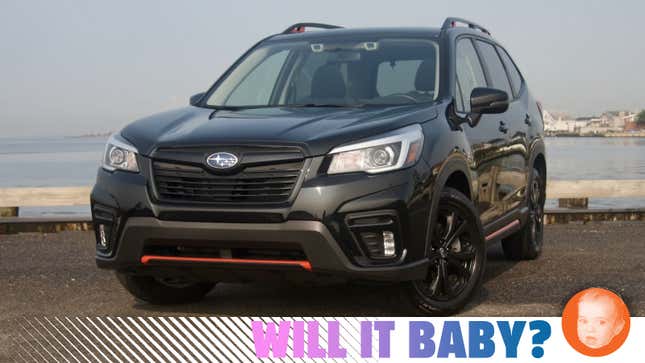
The redesigned-for-2019 Subaru Forester doesn’t top the charts at any one thing. But it does do a lot of things reasonably well, including serving as a capable, reasonably-priced family hauler.
(Full Disclosure: Subaru let me borrow a Subaru Forester Sport for a week, and dropped it off at my house with a full tank of gas.)
I’ve been driving a late-’80s Subaru wagon for more than a decade, and it’s been the perfect combination of quirkiness and utility. It’s not fast, but somehow it’s still fun, and it’s a good platform for everything from carting a group of friends through a blizzard to a ski slope to hauling a small block Chevy V8 home from some Craigslist score four states away.
Needless to say, when my son was born it dawned on me that I should probably get into something newer and better able to withstand an impact from any of the millions of 6,000-pound trucks and SUVs lumbering around on public roads these days. After all, it ain’t the ’80s anymore, so even half-assed efforts by automakers to downsize their vehicles disappeared with glam metal and analog car phones. My ’87 Subie is an anemic 2,600-pound tin can in amid a vast herd of high-powered anvils.
Naturally, I wanted to see what the direct descendant of my trusty car–the sixth-generation Subaru Outback–has to offer. What I found was that it’s more of an SUV than a car, and driving it has the same feel as loading a washing machine. Subaru’s flagship wagon had become bloated over the years and had lost whatever had made the Outback (and its predecessor, the Leone) different from other cars before Subaru redesigned it for the 2010 model year.
Then there’s the Crosstrek, a scrappy little hatchback that looked like it might have fit the bill. But alas, its trunk is minuscule, and like the car it would have replaced, it wasn’t big on power. So that one was out. I gave the Forester a sidelong glance, but had never been keen on its tall, boxy styling (preferring the low, sleek-boxy styling of the GL wagon.)
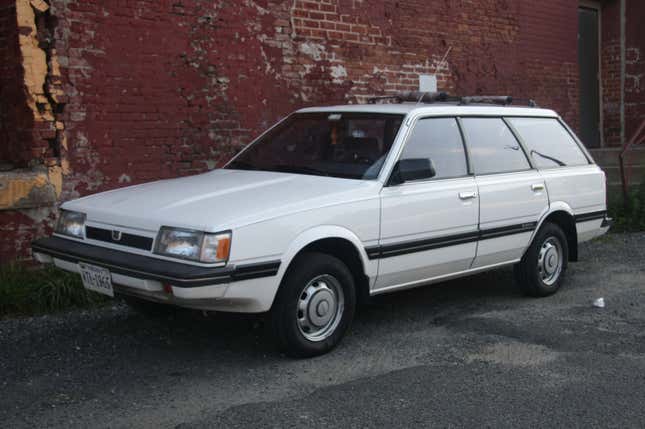
So my focus drifted for a while amid a sea of schlubby family haulers as I searched for an ideal blend of practicality and, well, more practicality. That’s why I had to immediately write off my favorite family cars–the Alfa Romeo Giulia Quadrifoglio, the Lamborghini Urus (the “famborghini” as I like to call it) and even the Kia Stinger–due to mundane considerations like not having enough money to pay for them.
Crossovers like the Honda CR-V and the Toyota RAV4 are popular for good reason, but I just didn’t like them. A bit too schlubby for my taste. The Honda Civic Sport and Volkswagen Golf GTI are delightful, but lack all wheel-drive. Sometimes it snows where I live, and there’s a beach you can drive on, so I’ve convinced myself that all-wheel drive and some ground clearance are necessary.
But the Forester I’d so despised in years past has grown up a bit. The fifth generation model introduced for the 2019 model year still looks like Forester, but it kinda looks like a real car, too somehow. It’s not as goofy-looking as it once was–having become a tall station wagon for the modern age with plenty of cargo room, all the latest safety features and an available sport trim complete with red accents and murder-black wheels.
It still isn’t particularly sporty, but I suppose that’s good for a family type like me who ought to be minding his Ps and Qs anyway.
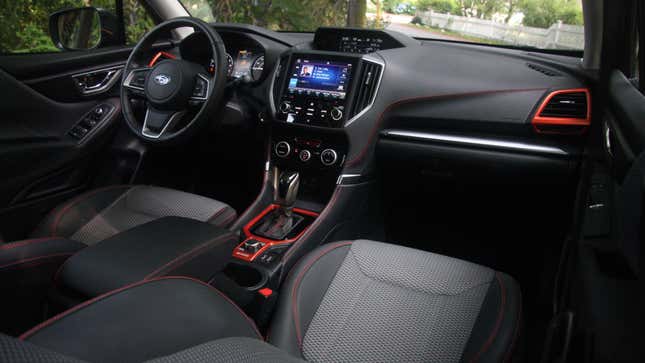
Cabin & Cargo
The typical family is inundated with stuff whenever it goes anywhere in the car. There are more groceries, more “we thought you could use this” items from family and friends and the odd commuter bicycle to pick up from the train station. And there’s the astronaut seat thing. I know I’m always harping about that, but a modern child safety seat is big enough to have its own ZIP code, so parents who once upon a time might have enjoyed the low cost and simplicity of owning a small car no longer have that option (unless they like traveling everywhere with their legs scrunched up against the dash).
The Forester isn’t as small as it used to be, and there’s a good amount of cargo space inside. Depending upon trim level, there are between 33 and 35 cubic feet behind the rear seats (there is no three-row option, so if you need seating for more than five passengers, you’ll want to look elsewhere). With the rear seats folded flat, total cargo area is between 71 and 76 cubic feet. The base trim level is the one with more space inside, which is something to keep in mind if you think you’ll need that handful of extra cubes. Between my Craigslist auto parts addiction and my mother-in-law’s propensity for sending us home with supplies, the extra cubes are welcome.
The seats are comfortable and spacious, and the Forester’s tall profile makes for plenty of headroom and clear visibility in most directions. (Like most modern cars, the C-pillars are pretty thick, so the Forester has the requisite blind spots.) Because of its tall rear doors, it’s easy to get your state-mandated astronaut seat in and out of the Forester if you need to. This orientation also makes it easier to load and offload squirming children into the middle seat without having to duck or contort your body too much.
LATCH child safety seat anchors can be the source of inspiration for truly remarkable bouts of parental swearing when they’re difficult to use. Fortunately, Subaru decided to go easy on us by devising little flaps–made from the same material as the seat and affixed on one end with velcro–to cover more-or-less un-shrouded steel loops to which the safety seat buckles are attached. In the past, I’ve praised automakers’ use of plastic flap doors, but these are better because they won’t break or get lost. Sure, if there’s a way to destroy them, children are more likely even than penitentiary inmates to find a way. But this easy-to-use solution seems like it will be more durable than most.
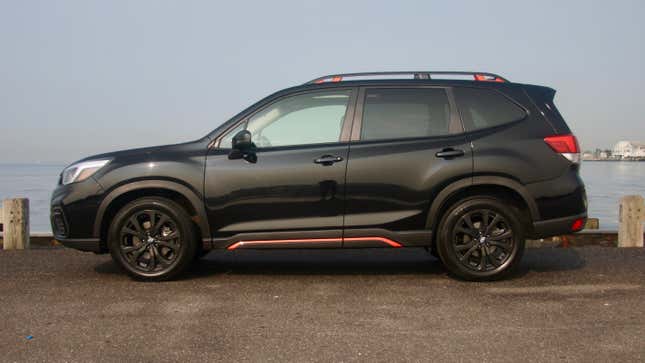
Driving & Fuel Economy
So many vehicles today sport EPA fuel economy numbers that look good until you drive with a little more gusto than the average grandmother and come face to face with disappointment. Other than the tiny ones, not many crossovers – all-wheel drive ones in particular–produce the goods. The Forester meets and exceeds expectations in this regard. For something of its size, weight and height, 30-plus-mpg fuel economy is unusual. So I was delighted to find that, despite my heavyish right foot, average fuel economy during a mix of city and highway driving was 30 mpg, or slightly above the EPA estimate.
The reason for such great fuel economy becomes clear as soon as you mash the accelerator pedal to the floor. Not a drag racer by any means, the Forester took more than 8 seconds to reach 60 mph in Car and Driver’s test of the vehicle. I didn’t conduct instrumented testing of the car, but I can tell you it feels sluggish when driven in anger. But when you operate it like a sane individual who is responsible for the tiny being(s) strapped into the space pod(s) in the back seat, its power output is more than adequate to get you from place to place.
Subaru’s flat boxer engine produces enough torque to propel the Forester smoothly between stoplights and onto the highway. Like almost every car on the market today, it will reach triple-digit speeds if you want it to. If you don’t know already, auto manufacturers’ (mostly successful) ploy to get everyone believing that fast acceleration is essential to safety is complete bullshit.
Handling, braking, and ride are fine, too. Or at least perfectly adequate for a practical family hauler, and way smoother and quieter than my tin-can-in-a-wind-storm ’87 GL. The Forester shines–and this applies to any Subaru, really–when road conditions deteriorate. Having driven a 2019 Forester in the snow, I can attest that the all-wheel drive system works exceptionally well. But I pushed it a little further than the average crappy winter slush. I drove the Forester out on the beach at my local surfing break, where the sand is soft and is about all my poor old ’87 GL can handle.
The Forester, which employs a center clutch in its front-rear torque distribution system, traversed the soft sand with aplomb. I didn’t even bother airing down the tires. That isn’t often the case with other all-wheel drive crossovers. In other words, I didn’t feel the fear I got in the offroad-ready-looking, but completely-unequipped-in-reality GMC Acadia AT4 that I was going to get stuck in the sand.
Also, while most modern crossovers feature flimsy fiber aero cladding under their floor pans, Subaru puts hard plastic panels under its cars that are much better able to withstand sand, mud, and deep puddles. Add in almost nine inches of ground clearance and you have a non-truck that’s surprisingly capable under trail conditions.
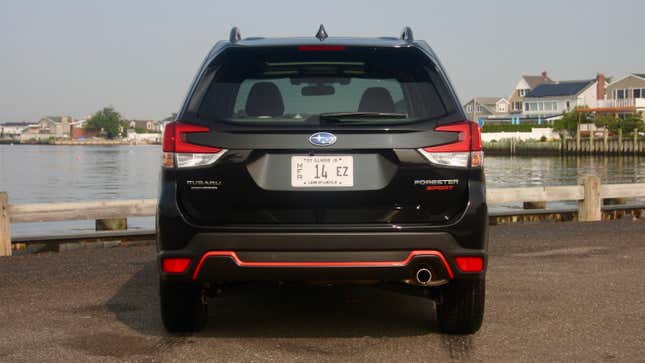
Safety
The 2019 Forester is an Insurance Institute for Highway Safety (IIHS) Top Safety Pick +. In addition to doing really well in IIHS’s comprehensive battery of crash tests, all Forester trim levels come standard with EyeSight, which includes adaptive cruise control, forward automatic emergency braking (AEB) and lane departure warning with lane-keeping assist. The blind-spot warning system, which IIHS has found to reduce collisions, is not available on the base-level Forester but is available on middle trims and standard on the higher-level trims. Smart high beams are only available on the top two trim levels. IIHS is pretty keen on those because they improve nighttime visibility. Reverse automatic braking is also available.
There is little doubt that active safety technology reduces the number and speed of crashes, but it still takes some getting used to. In New York City’s viscous, but somehow still intensely aggressive traffic, the Forester activated its AEB multiple times as frenetic jumbles of cars merged together on the pockmarked moonscape of a roadway. Getting close to other vehicles in this sort of situation is inevitable, so the sharp jolt of automatic brakes slamming the car to a stop here and there did little more than add to the aggravation of a grinding morning commute.
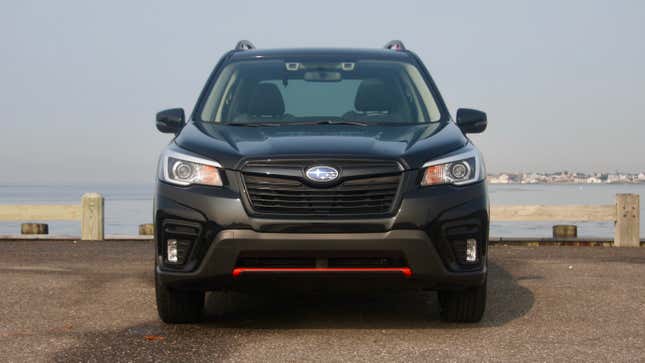
The Verdict
Remember The Three Bears? Of course you do. You probably read it to your kid the other night. Well, the Forester is like the last bowl of porridge in the bear cottage–not too cold, not too hot, but just right. You’re not going to be dominating track sessions in it (although I did once meet a guy who had swapped STI guts into his Forester), and it’s not as accommodating as a minivan. But it is more than adequate for meeting the daily needs of the average small family.
I first bought my ’80s Subaru because it was able to assume several roles–junk hauler, offroader, passenger transporter, fun machine–and handle all kinds of conditions for a modest amount of money. In that way, Subarus haven’t changed much over the years. They’ve simply become safer and more comfortable. The Forester Sport I tested, with its red accent stripes and blacked-out wheels, actually looked kind of cool, too. Well, cool from a practical dad’s perspective anyway.